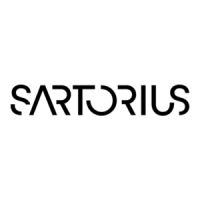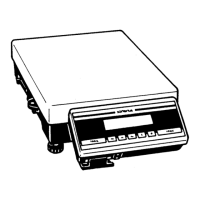Do you have a question about the Sartorius BP 3100 P-0CE and is the answer not in the manual?
Specifies allowable storage temperature ranges and precautions for handling.
Specifies environmental requirements for balance placement and operation.
Details how to connect the balance's main unit to the electronics box.
Guides the user on assembling the weighing chamber components.
Instructs on assembling the weighing chamber with a round glass shield.
Describes how to place components for a round weighing pan.
Details component placement for a rectangular weighing pan.
Explains how to connect the balance to mains power via AC adapter.
Outlines voltage selection for compatible power supplies.
Lists general safety measures for using the AC adapter and data interface.
Discusses compliance with FCC rules and potential interference.
Advises on safely connecting printers or PCs to the interface port.
Explains how to adjust the display unit's position for heavier balances.
Provides guidance on handling samples that cause static electricity interference.
Details leveling steps for specific balance types with rectangular pans.
Explains the required warm-up duration for accurate results.
Describes how to control the display and enter standby mode.
Details the automatic electronic self-test performed on startup.
Explains how to zero the weight display for accurate measurements.
Guides on performing basic weight determination.
Explains the internal calibration process using the balance's calibration weight.
Details the procedure for external calibration using calibration weights.
Describes how to access settings on verified balances by moving the switch.
Explains how to perform a calibration test using the internal calibration weight.
Details how to block calibration functions using menu code 197.
Describes connecting peripherals to the data interface port.
Instructs on how to attach an antitheft device using the rear lug.
Recommends regular servicing by a Sartorius technician for accuracy.
Provides instructions on how to clean the balance safely and effectively.
Details when to stop using the balance and contact service if issues arise.
Explains how to select and set specific functions using menu codes.
Provides a step-by-step guide to access and navigate the balance menu.
Explains how to exit the menu without saving new code settings.
Details the reset function to restore factory default menu codes.
Explains how to adjust balance settings based on ambient conditions.
Describes standard weighing and manual filling modes for optimal adaptation.
Details how to set the stability symbol display for weight variations.
Allows defining when the balance performs the taring operation.
Explains the zero-tracking function that automatically tares slight changes.
Covers functions for adjustment, calibration, and linearization using the CAL key.
Provides a list and conversion factors for various weight units.
Configures the data transmission speed for the interface.
Sets the parity bit for data transmission (Mark, Space, Odd, Even).
Configures the number of stop bits for data transmission (1 or 2).
Defines handshake modes for data transfer (software/hardware).
Sets parameters for data output, like print on request or auto print.
Controls the automatic printing of data, including start/stop.
Configures data output intervals for remote displays.
Enables automatic taring when data is printed or transferred.
Controls automatic printing of application parameters and results.
Explains how ID codes identify specific data types like net weight.
Allows output of tare memory values (last net value, total).
Defines access to the balance operating menu via the switch.
Explains menu access switch function for verified balances.
Describes how to block all balance keys except for the power key.
Allows configuration of the balance's power-on behavior.
Explains how to store tare weight automatically.
Demonstrates using tare memory for calculating tare, net, and gross weights.
Shows how to obtain printouts of tare, net, and gross weights.
Details how to compound and formulate weights with additive storage.
Explains how to obtain weight readouts as percentages of a reference.
Describes how to change the reference percentage for calculations.
Configures display settings for percentage readouts.
Demonstrates determining residual weight as a percentage.
Introduces the program for automatic conversion of weights to piece counts.
Shows how to display the set reference sample quantity.
Guides on changing the reference sample quantity for counting.
Demonstrates counting bulk quantities of items with the same weight.
Configures the start mode for animal weighing (manual or automatic).
Sets a delay for averaging until the animal calms down.
Allows adjustment of the number of subweighing operations for averaging.
Sets a minimum load threshold for reliable automatic starts.
Demonstrates automatic weighing of animals with subweighing operations.
Explains connecting devices for ISO/GLP compliant printouts.
Describes the printout format for calibration and linearization procedures.
Explains how to generate ISO/GLP compliant data records.
Details how application program data and parameters are printed.
Notes on electrical connections and potential interference.
Lists commands for adjusting the balance to ambient conditions.
Details software and hardware handshake parameters for data transmission.
Describes the auto print mode for continuous data output.
Lists external calibration weights, their classes, and order numbers.
Describes software for transferring data to a PC.
Details software for collecting and processing balance data.
Details the requirements met by the CE marking on equipment.
Operator responsibility for modifications and connections.
Addresses safety requirements for electrical equipment within voltage limits.
Explains the directive regulating mass determination in legal metrology.
Details services included in initial verification and installation.
Explains validity of verification based on national regulations.
Guides users on obtaining verification information and contacts.
| Type | Precision Balance |
|---|---|
| Capacity | 3100 g |
| Readability | 0.01 g |
| Calibration | External |
| Display | LCD |
| Connectivity | RS-232 |
| Linearity | ± 0.02 g |
| Pan Size | 180 mm |
| Repeatability (Std. Dev.) | 0.01 g |
| Power Supply | AC Adapter |
| Operating Temperature | 10°C to 30°C |











